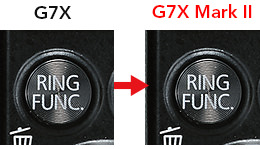PowerShot G7 X Mark II: Rebirth of One of the Most Popular Premium Compact Cameras in 2015!
The PowerShot G7 X - a high performance, premium camera that, despite its compact size, is equipped with a bright lens and large sensor, and that lets you easily take photos with bokeh. Its successor was announced on February 18th, and I had the chance to take the camera crowned the PowerShot G7 X Mark II for a live test to demonstrate its capabilities. This article is my first impression of the camera as a professional photographer. (Reported by: Ikuko Tsurumaki)

Enhanced grip and advancements in user operability
The Canon PowerShot G7 X, purportedly one of the most popular premium compact cameras in Japan in 2015, has been given a new lease of life with the announcement of the PowerShot G7 X Mark II.
At a glance, there doesn’t seem to be much difference between this and the PowerShot G7 X. However, the re-designed grip provides a non-slip surface that lets you hold on better to your camera while adding to the premium feel of the exterior. As for the finer details, the control wheel on the rear of the camera has been enlarged, and the etching on the buttons made thinner. The raised borders around the buttons have also been removed. These changes might be slight, but these alone show the thought that has gone into its smart design with ease-of-use in mind. You are also now able to customise the control ring by choosing between stepped or continuous movement, which reflects how the camera has been designed for user operability.


For details on the PowerShot G7 X Mark II, click here

Point 1: Equipped with the latest image processor, DIGIC 7
Image clarity is improved when using high ISO and when shooting with small apertures. Tracking performance is also enhanced, allowing the camera to instantly detect and follow subjects.

Point 2: Rear LCD monitor can be tilted downward by 45°
The conventional upward tilt of 90° is ideal for taking selfies. The monitor can now also be tilted 45° downward, which is handy for high angle shots.

Point 3: 4 stop image stabilization with Dual Sensing IS
Information received by the image sensor is handled by an algorithm that achieves 4 steps of optical image stabilization, significantly reducing camera shake.
A: Gyro sensor
B: Imaging sensor
C: DIGIC 7

Point 4: Control ring for adjustable between stepped or continuous operational feel
The control ring on predecessor models made a definite clicking sound when turned. You can now also make the ring significantly quieter. Setting it to continuous movement allows you to fine-tune the zoom without any sound.
Enhancements from the PowerShot G7 X

Enhancement 1: Grip on the body
The G7 X had a smooth, square look, but in response to user requests, we added a grip to the body for a more secure feeling when held.

Enhancement 2: Changed mode dial
The Creative Shot and Creative Filter modes have been removed from the shooting modes available on the Mode Dial.

Enhancement 3: Newly-designed button
The G7 X had a button designed with protruding edges. However, this has been changed to a smoother edged button on the G7 X Mark II.
Automatic functions for impressive shots and flawless anti-shake for high image quality
Equipped with the new DIGIC 7 imaging processor and other new functions, image quality has undergone a dramatic improvement. Noise reduction using up to 14 times the amount of information of predecessor models increases the resolution for high sensitivity photography, so even when I shoot at ISO 1600, edge noise is so well suppressed it may easily be mistaken for a shot taken at ISO 800. When we enlarged data captured at night or indoors on a PC, the noise was virtually unnoticeable. We also confirmed that the dark areas of the photos were smooth, making for beautiful images. Moreover, the drop in perceived resolution caused by diffraction when shooting at small apertures is kept to a minimum. It is also easier to capture expressions in deep focus at smaller f-numbers. Furthermore, exposure composition is now made more natural with improved image quality thanks to the Auto Lighting Optimizer.

PowerShot G7 X Mark II/ FL: 36.8mm (100mm equivalent)/ Shutter Priority AE (f/4, 1/8 sec., EV±0)/ ISO 125/ WB: Auto
Seagulls waiting to get some food at Shinobazu Pond one evening in Ueno, captured at a 100mm telephoto end. A natural bokeh effect appears in the background, making the main subject (the seagulls) stand out more. The bokeh circles are also beautifully captured.

PowerShot G7 X Mark II/ FL: 8.8mm (24mm equivalent)/ Aperture Priority AE (f/1.8, 1/125 sec, EV±0)/ ISO 125/ WB: Auto
Here, the focus is on a mannequin wearing sunglasses. I placed the stores selling flashy clothing, along with the lighting, in the background to bring out the atmosphere of the miscellaneous and cheap items on sale in Ameyoko. The bokeh effect at the maximum aperture of f/1.8 is beautiful.
Dual Sensing IS, said to be the centrepiece of the DIGIC 7 processor, makes 4-stop image stabilization possible. Even in dark scenes, I was able to take shots at a 100mm telephoto end without hesitation. The tracking function, which you can't do without for photographing children and pets, has been made faster. In particular, as I personally experienced, the speed of the focal position detection in Auto mode was dramatically improved.

PowerShot G7 X Mark II /FL: 36.8mm (100mm equivalent)/ Aperture Priority AE (f/11, 1/8 sec, EV-0.7)/ ISO 800/ WB: Auto
There was a couple waiting for the signal to cross an intersection. I composed the photo to capture the wet road and signs of Ginza Station in the background in order to bring out the essence of city life. The image stabilization function is powerful, with no blur at 100mm even at a 1/8 second shutter speed.
There are other advanced features such as in-camera RAW conversion, but the most interesting of these is the Panning function, which has been added to the scene modes. In the bid to get only the background beautifully panned, i.e. blurred in a way that shows motion, the shutter speed to use is difficult to determine as there is a perpetual concern that the photo will turn out simply blurry. However, if you select Panning mode, subject blur is prevented with IS, and the panning speed is determined by the camera, which will automatically select the appropriate shutter speed. When I tried out this function myself to shoot bicycles, animals, and so on, I was amazed by how easy it was.
Even though the PowerShot G7 X Mark II is a camera equipped with simple functions that I would recommend for beginners, its capabilities and compact form make it a camera that even a professional would want to carry around for normal use.

PowerShot G7 X Mark II/ FL: 8.8mm (24mm equivalent)/ Panning (f/7.1, 1/20 sec, EV±0)/ ISO 125/ WB: Auto
This shot of a bicycle dashing along was taken in Panning Mode. The camera's ability to automatically set the appropriate shutter speed is a welcome feature. The image stabilization function makes panning a cinch.
Comparing the specifications of the new and old models
*Red text indicates an advantage
Pixel count
PowerShot G7 X Mark II
20.1 megapixels
(approximate)
PowerShot G7 X
20.2 megapixels
(approximate)
Focal length
PowerShot G7 X Mark II
8.8 to 36.8mm
(35mm-equivalent of 24 to 100mm)
PowerShot G7 X
8.8 to 36.8mm
(35mm-equivalent of 24 to 100mm)
Maximum aperture/IS
PowerShot G7 X Mark II
f/1.8 – 2.8/ 4 stops
PowerShot G7 X
f/1.8 – 2.8 / 3 stops
Imaging processor
PowerShot G7 X Mark II
DIGIC 7
PowerShot G7 X
DIGIC 6
Shutter Speed
PowerShot G7 X Mark II
30 to 1/2000 sec., BULB
PowerShot G7 X
250 to 1/2000 sec.
Rear LCD screen
PowerShot G7 X Mark II
3.0-inch type, approx. 1.04 million dots, tilt up 180°, down 45°
PowerShot G7 X
3.0-inch type, approx. 1.04 million dots, tilt up 180°
Size (approximate)
PowerShot G7 X Mark II
105.5 × 60.9 × 42.2mm
PowerShot G7 X
103.0 × 60.4 × 40.4mm
Weight (approximate, including battery and memory card)
PowerShot G7 X Mark II
319g
PowerShot G7 X
304g

Born in Tokyo in 1972, Tsurumaki started learning photography while working with an advertising agency, and became a photographer after her career as an assistant. She is currently engaged in activities including photo shoots for magazines, writing articles, and conducting photography lectures and seminars.

A monthly magazine that believes that enjoyment of photography will increase the more one learns about camera functions. It delivers news on the latest cameras and features and regularly introduces various photography techniques.
Published by Impress Corporation

































